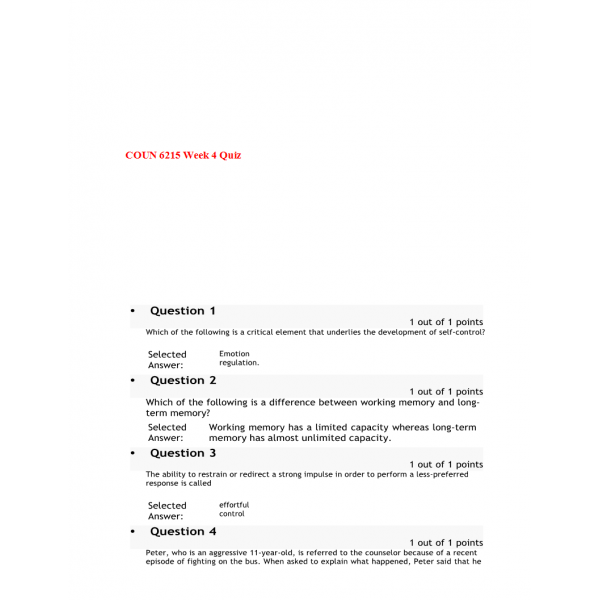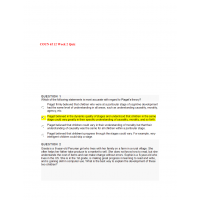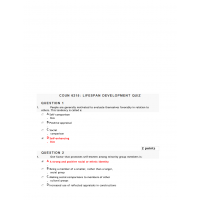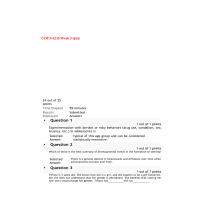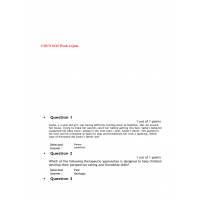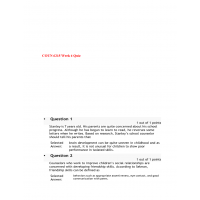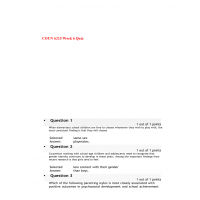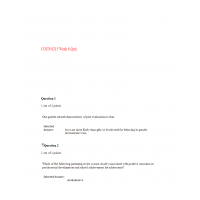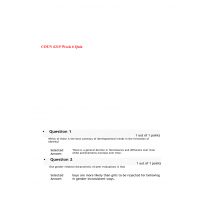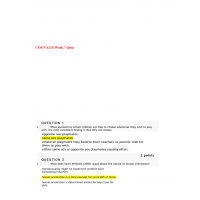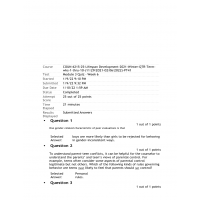COUN 6215 Week 4 Quiz (V1)
COUN 6512 Week 4 Quiz
1. Which of the following is a critical element that underlies the development of self-control?
2. Which of the following is a difference between working memory and long- term memory?
3. The ability to restrain or redirect a strong impulse in order to perform a less-preferred response is called
4. Peter, who is an aggressive 11-year-old, is referred to the counselor because of a recent episode of fighting on the bus. When asked to explain what happened, Peter said that he had to sit next to a girl who was laughing with her friend across the aisle about the “stupid kids in school.” Enraged by this, Peter pushed her head into the window. What is the most likely explanation for Peter’s aggressive reaction?
5. Individuals with low levels of self-esteem would be more likely than those with high self- esteem to
6. Imagine that you are counseling a 6th grader on how to improve her study skills so that she will remember more information on tests. Not only do you teach her some memory strategies, you also encourage her to engage in self-testing so that she will begin self- monitoring, that is, keeping track of how well she is remembering new material. What kind of skill is this kind of
7. For counselors who work with families that include children of different ages, which of the following statements is true?
8. Sasha, a 3-year-old girl, was having difficulty settling down at bedtime. She ran around her house, trying to make her parents catch her before getting into bed. Sasha’s behavior awakened her baby sister, asleep in the next room. John, Sasha’s father, felt pushed to his limit and he screamed at Sasha to stop and threatened her with a spanking. Which type of discipline did Sasha’s father use?
9. Which of the following statements is true with respect to moral development?
10. Which of the following therapeutic approaches is designed to help children develop their perspective taking and friendship skills?
11. Counselors who do parent training primarily use which approach for this work?
12. According to Crittendon’s model, infants who have anxious-ambivalent attachments have experienced which pattern of learning or conditioning?
13. Charles was a temperamentally irritable baby who was difficult for his parents to handle. Now at 6, he is showing behavior problems in school. He has not mastered his alphabet letters and gives up easily. Charles’ parents also have difficulty making rules stick with him at home. They remember how easy their other two children were to raise and now have less patience with their youngest son. Based on research, which of the following characteristics is least likely to be related to Charles’ conduct problems?
14. Our knowledge of an event in our own lives, such as a family vacation, is a type of
15. Becoming aware of the “Me” self, the self that recognizes one’s gender and age, occurs roughly around what age?
16. Jeremy, a 2nd grader, is in the counselor’s office because he hit another boy on the playground. He tells the counselor that he knew the other boy was about to hit him first. He was just “getting back” at the other student. The counselor tries to help Jeremy control his aggressive behavior by explaining that the other boy didn’t intend to hurt him. Given what you have learned about social development, which of the following is your best recommendation for the counselor?
17. Levels of social cognitive do not always match .
18. Some research shows that cultural values and goals shape the kinds of discipline that parents use with their children. One example is that Puerto Rican mothers wanted their children to recognize their obligations and connectedness to others; their goals for their children were more than the goals of European American mothers.
19. According to research on self-concept in children, which of the following aspects of self-concept is most closely tied to overall level of self-esteem?
20. Piaget’s description of the differences between preoperational thought (characteristic of preschool aged children) and concrete operational thought (characteristic of elementary school aged children), includes which of the following?
21. Alex is 22 months of age. He knows that he should not play with his food at the dinner table, but he sometimes still does so. His parents can usually redirect his behavior with simple reminders about what he should be doing. What is happening cognitively to help him grow in self-control?
22. Jamie, a boy scout, has practiced tying a particular kind of knot dozens of times, and he does it quickly and efficiently. But when he tries to explain how to do it to a younger member of his troop, he can’t put it into words, he can only show the other boy how to do it. Jamie’s knowledge of knot tying is an example of
23. The term refers to the description of a person’s attributes, whereas the term refers to how a person feels about those attributes.
24. It is generally a best practice for counselors to approach working with youngsters who demonstrate anger, noncompliance, and aggression in which of the following ways?
25. As Selena and her friends are walking home after school they approach a corner store and see bags of candy and snacks on open shelves outside the front door. A young clerk is also outside waiting for customers. As they get closer, they see the clerk go inside the store. Selena’s friends encourage her to take a bag of candy, but she refuses. How would an individual in Kohlberg’s preconventional stage of moral reasoning explain Selena’s behavior?
| Institution & Term/Date | |
| Term/Date | Walden University |
-
$9.99

